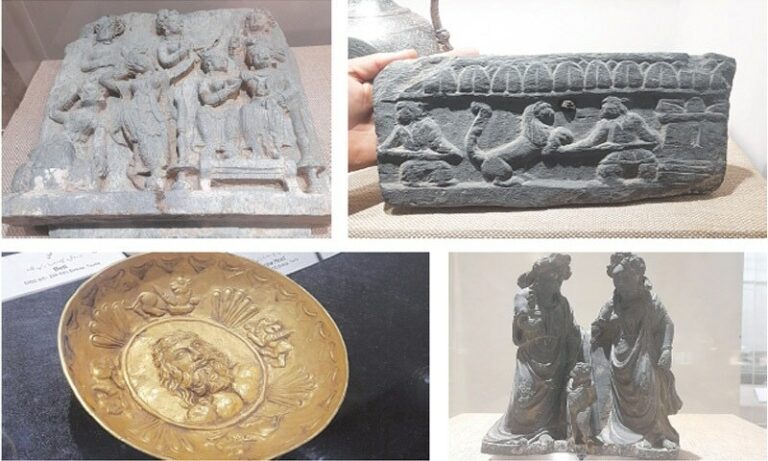ISLAMABAD: After being on display at a renowned gallery in China for over a year, the Gandhara Art Exhibition has returned to Pakistan with 10 historic artworks on display at the Islamabad Museum, including a stunning 2nd-3rd century relic depicting the life of Lord Buddha as a prince that had been kept in storage for 17 years.
The greenschist artefacts, mainly found in the Swat Valley, had been kept in storage after returning from an exhibition in Europe in 2007.
“The artefact was taken out of storage last year when China selected the item. We decided to display it after 17 years,” said Dr Abdul Ghafoor Lone, director of the Department of Museums and Archaeology (DOAM) Islamabad.
This stone artefact depicts the Buddha’s life in his palace before he attained enlightenment.
It depicted a young prince and his wife, celestial figures playing music, and dancing subjects.
The Gandhara exhibition was organised in conjunction with the celebrations of the 70th anniversary of the establishment of diplomatic ties between Pakistan and China.
65 artworks were loaned from National Museum of Pakistan Karachi, 10 from Islamabad Museum, 16 from Taxila Museum and 82 art pieces from museums in Khyber Pakhtunkhwa (KP) – Peshawar Museum, Swabi Hund Museum, Dir Museum and Swat Museum.
The relics will be sent to the Palace Museum, Beijing, China in January 2023, with the opening ceremony of the exhibition held on March 15, 2023. After a three-month exhibition at the Palace Museum, Beijing, China, the first traveling destination of the Gandhara Art Exhibition was the Gansu Provincial Museum from September 8 to December 8, 2023.
The second stop was the Shenzhen Museum in Guangdong Province, China from December 24 to March 24, 2024.
China has been borrowing artefacts from Pakistan under an agreement since 2010, allowing ordinary Chinese to learn about Pakistan’s cultural and religious diversity.
“The Chinese people will be able to know that Pakistan is not just an Islamic country but is also home to important Buddhist traditions. This will boost tourism to Pakistan where tourists can experience an unparalleled Buddhist collection,” Dr Abdul Ghafoor said.
The 10 pieces on display at the Islamabad Museum also include grey and black schist pieces from Peshawar and Mardan.
Among the items on display are some confiscated from treasure hunters, including a solid gold drinking vessel dating to the 3rd or 4th century bearing an image of Dionysus, the Greek god of wine and pleasure.
The Varia collection’s 2nd and 3rd century artefacts included a spectacular piece depicting a lion hunt scene, suggesting Greek influence.
The work was discovered in Swat by an Italian exhibition during research in the 1960s.
The remaining artefacts housed in the National Museum, Karachi, Taxila Museum and KP Provincial Museum have been returned to their respective institutions.
Published in Dawn on May 27, 2024

